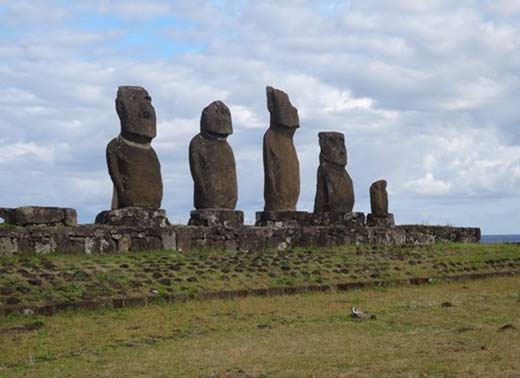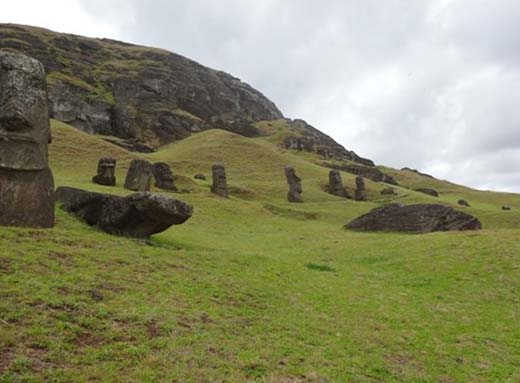
Easter Island
Speaker: Susan Rogers
Tuesday, 25 April 2023
The guest speaker at the u3a Todmorden Members Meeting on 20 April was Susan Rogers, with a talk about Easter Island. She began by telling us that there are no authentic and original written records about the island itself from the people who were there before the seventeenth century.

Nearest to such records was the discovery, in the 1800s, of wood panels engraved with symbols and other marks, known as Rongarongos. However, subsequent attempts to decode, or read, what they mean have been unsuccessful so far.
The island is extremely remote, the nearest large country being Chile, some two thousand plus miles to the east, who govern it.
One of Susan's first slides showed the island in a painting from many years ago as lush, and heavily forested, compared with the landscape of today; deforested, with a sparse and rocky surface. There are no rivers or streams, the islanders depend on rainfall for their water supply. A notable feature of the island is a runway of seven miles. Few of the audience knew that this was to enable the space shuttle to land after returning to earth if required.

The island is also known as 'Rapa Nui', as are the native population, and other of its features. The more familiar name used today comes from its visit in 1774 by Captain James Cook, on Easter Sunday. It is thought that the island was first populated by a mixture of American and Polynesian people, but reports from around this time mention the island, and its population, deteriorating. In the next century, the islanders suffered even more when slave traders took up to two thousand people as slaves to work in farming in Peru.
Subsequently, Chile annexed Rapa Nui and took even more of its male occupants, this time to serve in the Chilean army. Taking over the governance of the island, Chile tried to repopulate it by moving Chilean people to live there. This experiment wasn't successful, and many of these new occupants, and probably even more of their children, returned to Chile.
Around the same time, other settlers from Tahiti arrived and started to raise sheep on the island, to such an extent that the people were moved, or fenced into, settlements to make room for the animals, which subsequently numbered around seventy thousand, to graze on most of the land – perhaps one of the causes of the barren landscapes of Rapa Nui. Into the twentieth century, and Chile itself suffered under the tyranny of General Pinochet, who placed Rapa Nui under martial law.
Speaking about the island's people over the years, Susan had illustrations of the ancient housing, settlements where there would have been a Chief, who occupied a large oblong shaped building, and the ordinary people who had smaller, circular houses. There had been quite a distinct class system, based largely on the size of peoples' ears. People with long ears were of higher class and status, than those with shorter ones. The chiefs are known as Arikis and some of them are believed by the islanders to have been descended from the gods.
The feature which most of us are familiar with are the statues on Easter Island but, as Susan had mentioned, there is no definitive information about how they were made, and how they were moved and positioned.
The statues themselves are known locally as Moai and they were individually carved of rock from the volcano Rano Raraku, which erupted two and a half million years ago on the island. They were partly carved in single bays of the rock, rather than a big open area like a modern quarry. The carving is thought to have started on a vertical plane and, when the statue, or part of it, was completed detached from the rock. It would then have been stood up and the back of it was dressed, a term of 'finishing off'. There are three distinct parts of the statues. The Pukao are the hat-like structures or topknots, the Moai is actually the human statue and the Arpua is the base that the statue stands on. Susan showed us one of several video clips from a film, showing how the Moai may have been constructed.
There are around 1000 statues, up to 86 tons in weight and 10 metres in height, though the average size is around half of that. It was originally thought that many of the statues were placed on the edges of the island to frighten potential invaders away, but most of them are facing inwards. Many more statues or, in some cases, parts of statues haven't been erected, or even completed and their parts remain in quarries and around the island. It is thought that this may have been because the islanders who designed and supervised the production, siting and erection of them were extremely proud of their work and would simply stop the process if there was any sort of defect or poor workmanship. It is estimated that each of the completed statues would have taken around two years to make.
Another film clip showed how the Moai may have been moved from place to place. One method was moving the statues using tree trunks as rollers. The statues are so heavy that the trunks would splinter and break after one use. Another suggestion, or theory, was that the smaller statues might have been 'walked' to where they would be sited, using slaves to manhandle a whole statue or its parts from one place to another. A number of the statues on Moai are no longer standing. Different theories exist of how and why this happened, such as the effects of earthquakes or tsunamis. A superstitious theory is that the Moai witnessed the declining or suffering of the islanders, leading to them being pushed over. The 'toppled' statues are always face down.
UNESCO recognized Easter Island and Rapa Nui State Park as a Chilean site of global cultural heritage in 1995.
Susan offered her own reflections and accounts of her visit to the island some years ago – visiting its prison, which held just the one prisoner with three guards. She showed us a wood carving made there which cost £25 – a similar one on another island cost six times as much. A supermarket she visited had hardly anything on the shelves, the island being totally dependent on imports. Her picnic ingredients of some bread rolls and cheese cost her around £15.
Efforts are being made by the seven to eight thousand current islanders to achieve autonomy rather than being governed by Chile, and they have also begun to address the shortage of trees by importing sustainable replacements. Susan ended by saying their spirit and determination convinced her that they will endure and continue to live in this unique place… with their iconic stone companions.
The next Todmorden U3A Monthly Members Meeting will be on Thursday 18th May, open to all fully paid-up members at the Central Methodist Hall, Todmorden. The speaker for this meeting is Stephen Caunce, with 'History of the Co-op'.
Not yet a member? You can attend one talk free by requesting an invitation to this zoom event. We're always delighted to welcome new members. Contact details: website at www.u3atod.org.uk or email at info@u3atod.org.uk.
Many thanks to Colin Sanson for this report
Previous U3A reports on the HebWeb - click here

